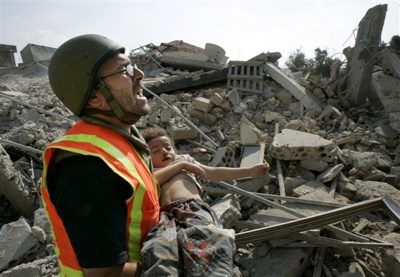Pictures from Qana
Hanady Salman, an editor at as-Safir newspaper, writes about today's massacre in Qana:
The 1996 Qana massacre was largely ignored by the international community after the initial outrage that forced Israel to stop its "Grapes of Wrath" operation. But there never was any follow up beyond condemnations by human rights groups, as the Wikipedia entry linked above notes:


Qana - Sunday July 30th , 2006She also sent pictures, which have been uploaded to the Flickr account. As always, be warned: they are very graphic. There is also a previous set from a few days ago here, and another of the environmental damage done by oil spills from Israeli warships on Lebanon's beaches.
Only to let you know that these are 55 civilians, all killed , 20 of them are kids betwween 7 months and 12 years old.
Only to let you know that a number of these children are handicapped, they were hit in the last Qana massacre in 1996.
Only to let you know CNN and BBC are hosting IDF spokespeople who tell the world that these civilians were warned to leave , but they just didn't.
Only to let you know the air strikes took place at 1:00 am , all they people were sleeping, in their pyjamas, bare feet, in a shelter. The house was hit twice. Twice. To make sure they will all die.
Only to let you know that despite the fact that we're animals, but it would have been impossible for animals to sleep had there been any shelling from anywhere close , as the IDF alleges.
Only to let you know you free media won't show you these pictures.
Only to let you know that this is not the first time this happens , and I can promise you it won't be the last time.
The 1996 Qana massacre was largely ignored by the international community after the initial outrage that forced Israel to stop its "Grapes of Wrath" operation. But there never was any follow up beyond condemnations by human rights groups, as the Wikipedia entry linked above notes:
Amnesty International conducted an on-site investigation of the incident in collaboration with military experts, using interviews with UNIFIL staff and civilians in the compound, and posing questions to the IDF, who did not reply. Amnesty concluded, "the IDF intentionally attacked the UN compound, although the motives for doing so remain unclear. The IDF have failed to substantiate their claim that the attack was a mistake. Even if they were to do so they would still bear responsibility for killing so many civilians by taking the risk to launch an attack so close to the UN compound."Ten years later and Israel carries out the same attack. It might have not if senior officers who made the decision had been pursued for war crimes, of if the US had put pressure or ended weapon shipments to a state that is a serial war crimes committer, it might not have happened.
Human Rights Watch concurred, "The decision of those who planned the attack to choose a mix of high-explosive artillery shells that included deadly anti-personnel shells designed to maximize injuries on the ground -- and the sustained firing of such shells, without warning, in close proximity to a large concentration of civilians -- violated a key principle of international humanitarian law."


